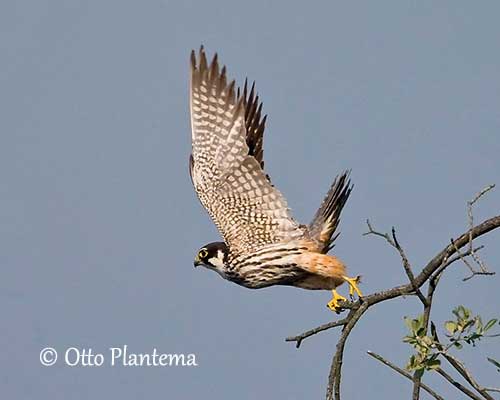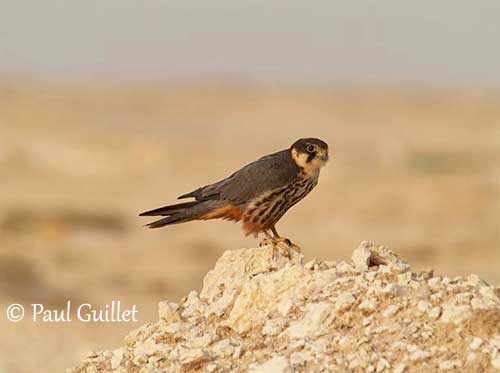
Fr: Faucon hobereau
Ang: Eurasian Hobby
All: Baumfalke
Esp: Alcotán Europeo
Ita: Lodolaio
Nd: Boomvalk
Sd: Lärkfalk
Photographers:
Jean Michel Fenerole
Photos d’Oiseaux du monde
Paul Guillet
Photos d’Oiseaux
Otto Plantema
Trips around the world
Ingo Waschkies
My bird pictures on Pbase
Nicole Bouglouan
PHOTOGRAPHIC RAMBLE
Text by Nicole Bouglouan
Sources:
HANDBOOK OF THE BIRDS OF THE WORLD Vol 2 by Josep del Hoyo-Andrew Elliot-Jordi Sargatal - Lynx Edicions - ISBN: 8487334156
GUIDE DES RAPACES DIURNES – Europe, Afrique du Nord et Moyen-Orient de Benny Génsbol – Delachaux et Niestlé – ISBN : 2603013270
THE COMPLETE BOOK OF BRITISH BIRDS – Written by “Royal Society for the Protection of Birds” experts - Préface de Magnus Magnusson - Michael Cady- Rob Hume Editors - ISBN: 0749509112
THE HANDBOOK OF BIRD IDENTIFICATION FOR EUROPE AND THE WESTERN PALEARCTIC by Mark Beaman, Steve Madge - C. Helm - ISBN: 0713639601
BIRDS OF THE MIDDLE EAST by R.F. Porter, S. Christensen, P Schiermacker-Ansen C.Helm - ISBN: 0713670169
LES OISEAUX D’EUROPE ET D’AFRIQUE DU NORD par Hermann Heinzel, Richard Fitter, John Parslow - Delachaux Niestlé - Isbn : 2603014862
Biodiversity Explorer – The Web of Life in Southern Africa
Wikipedia, the free encyclopaedia
What Bird-The ultimate Bird Guide (Mitchell Waite)
European Raptors – Biology and Conservation
Eurasian Hobby
Falco subbuteo
Falconiformes Order – Falconidae Family
INTRODUCTION:
The Eurasian Hobby is a small, elegant falcon with remarkable skill in the air. Its fast, powerful flight allows it to catch insects and birds on the wing. It often hunts at dawn and dusk and insects are often eaten during the flight. Like most Falconidae, it performs spectacular aerial displays.
It frequents open country interspersed with woodlands and forest with large clearings.
It breeds across Europe and Asia, and winters in sub-Saharan Africa, India and SE Asia.

DESCRIPTION OF THE BIRD:
Biometrics:
Length: 29-36 cm
Wingspan: 74-84 cm
Weight: M: 130-232 g – F: 140-340 g
The Eurasian Hobby adult has dark slate-grey upperparts with uniform grey tail. The whitish or buff underparts are densely streaked black, but thighs and undertail-coverts are rusty-red. Underwing and undertail are densely barred and spotted dark grey.
On the dark head, cheeks, chin, throat and neck sides are white, and contrast strongly with the conspicuous black moustache and ear-coverts. We can see white narrow eyebrows that join at base of upper mandible.
The hooked bill is black with yellow cere. The eyes are dark brown, surrounded by narrow, yellow eyering. Legs and feet are yellow to orange-yellow.
The Eurasian Hobby has long, scythe-like, pointed wings and fairly short tail. In flight, it often resembles a large swift.
Male and female have similar plumage, but the female is slightly larger than male.
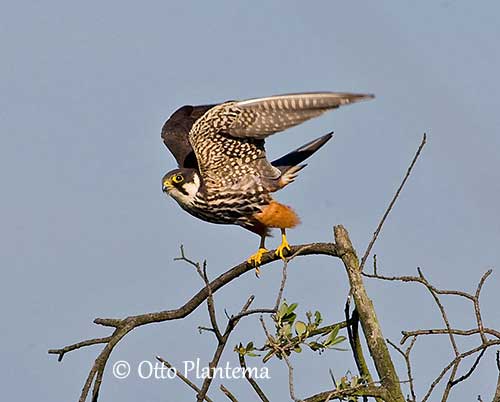
The juvenile is browner above, with pale edges to feathers involving scaled effect. Undertail-coverts and thighs are buff instead of rusty-red. The crown is paler than in adults. The tail shows a narrow, pale terminal bar. The underparts are pale buff.
The immature (2d year) resembles adult but the tail is like in juvenile. Thighs and undertail-coverts are much paler than in adult. The underparts are pale buff.
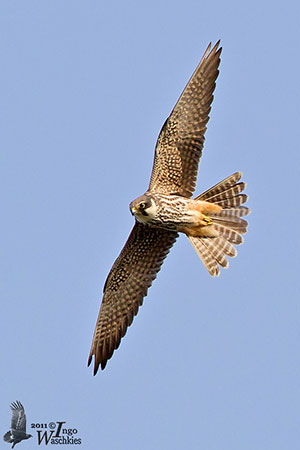
SUBSPECIES AND RANGE:
The Eurasian Hobby has two subspecies.
F.s. subbuteo breeds in Europe and NW Africa, E through Russia, C Asia, N Pakistan, N India, Nepal and N China to Kamchatka, Sakhalin and N Japan (Hokkaido).
It winters in C and S Africa, and S and SE Asia.
F.s. streichi occurs in S and E China and maybe also in N Myanmar and N Indochina.
This race is mainly sedentary.
The Eurasian Hobby has been recorded in Alaska, on the Aleutians and other islands, and once on mainland North America, S to Washington and NE, S to Massachusetts.
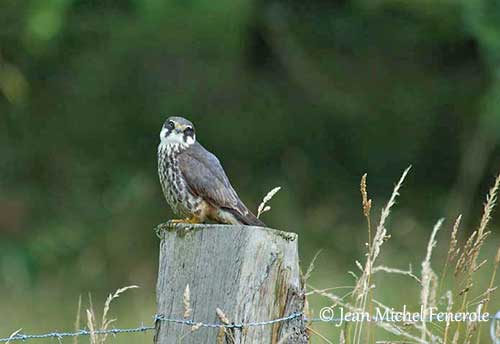
HABITAT:
The Eurasian Hobby frequents open country including farmland, marshes, savanna and taiga. It can be seen in lowland where scattered woodlands provide good nesting sites. Prior to the breeding season, it often feeds in wetlands.
The species occurs mainly in lowlands or foothills, but it can be seen in mountainous areas too, up to 4000 metres of elevation in India.
During winter, it frequents open moist woodland and forest edges. It may forage in more open habitats such as coastal dunes, Brachystegia woodland (Miombos) and savanna, and occasionally in suburban areas.
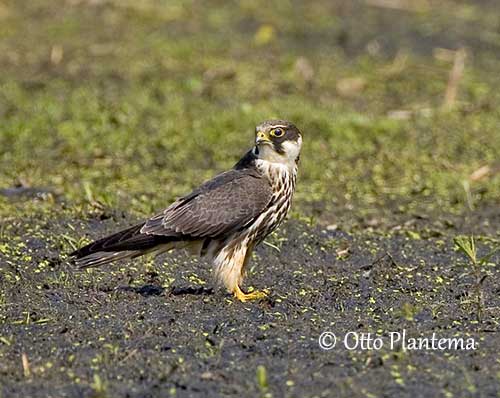
CALLS AND SONGS: SOUNDS BY XENO-CANTO
The Eurasian Hobby is usually silent on the wintering grounds. However, during the breeding season, it gives a rapid, sharp, plaintive “kew-kew-kew-kew…”
A slower, softer “tyew tyew tyew tyew” can be heard during the nesting period.
Like in other small falcons, the pitch is higher on the first notes.
BEHAVIOUR IN THE WILD:
The Eurasian Hobby feeds mainly on birds and large insects. Birds are the main food during the breeding season and include Slylarks, starlings, House Sparrows, Tree Sparrows and other small songbirds. This raptor is able to fly at great speed while hunting. It attacks its preys by surprise, emerging from behind houses, hedgerows and at forest edge. It is able to catch swallows, martins and swifts on the wing.
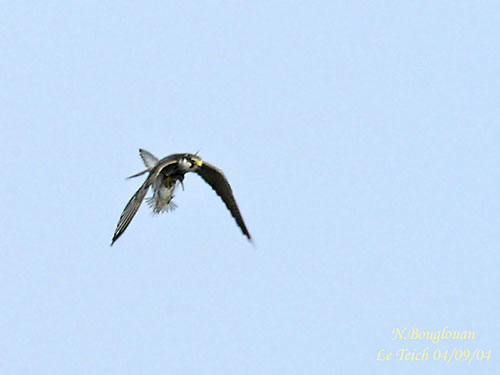
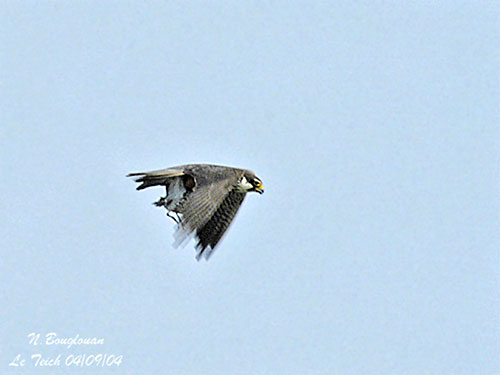
Carrying a Dunlin
caught in wetland
Carrying a Dunlin
caught in wetland
It also catches flying insects such as dragonflies, beetles, moths, grasshoppers, locusts, crickets and ants. Insects are usually eaten while flying, holding them in talons to dissect and eat. According to the range, it also catches bats and lizards.
The Eurasian Hobby hunts with fast, acrobatic flight while pursuing a prey. It is very active at dawn and dusk, visiting colonies and roosts of bird species.
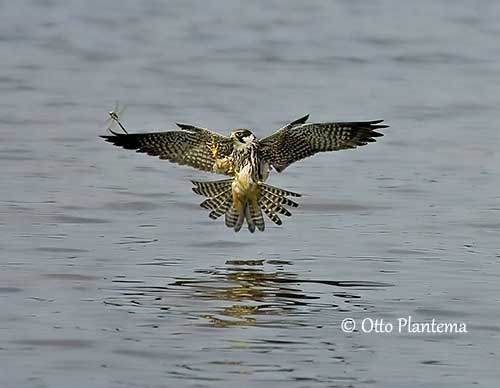
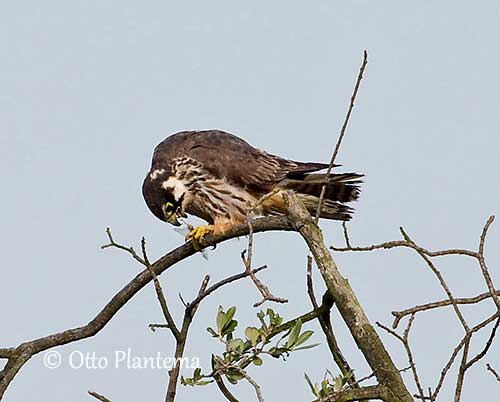
During the breeding season, both mates perform spectacular aerial displays including aerial “food-passes” during which the male passes a prey to the female while flying at great speed. Other displays show the male flying in front of the perched female.
The pair may form on the wintering areas or during the return migration. Some pairs may have long-term pair-bonds, but more information is required. They are monogamous.
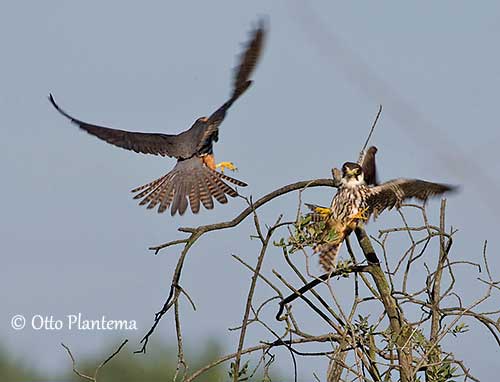
The Eurasian Hobby of nominate race is migratory and winters in sub-Saharan Africa. They reach South Africa in November. The eastern populations of S and SE Asia winter mainly in Indian Subcontinent and S China.
They usually return to their breeding grounds in late April and May, and leave after breeding in August/September.
They migrate on broad front above Sahara and Mediterranean.
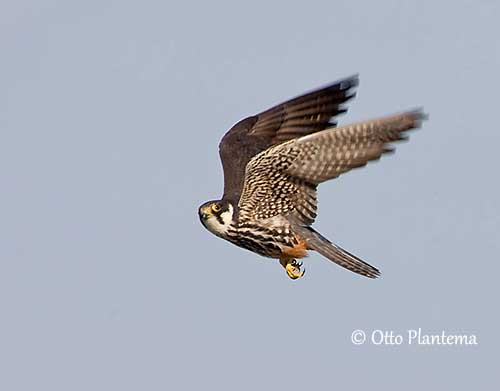
The Eurasian Hobby has swift and agile flight, with powerful, steady wingbeats interspersed with long glides. It often soars with the wings held level and straight-out, and the tail more or less spread. It may hover occasionally.
A great acceleration occurs when hunting birds, with deeper and faster wingbeats, broken by short glides on swept-back wings.
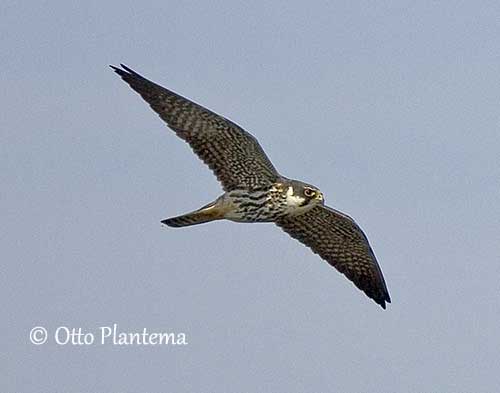
REPRODUCTION OF THIS SPECIES:
The laying occurs fairly late, usually June/July, or late May in some parts of the range. The Eurasian Hobby is solitary nester, and unlike other Falconidae, it does not build a nest. It usually uses abandoned nests of Corvidae or other raptors, and does not add material. It selects nests placed in trees, mainly pines, but also other conifers or broad-leaved trees, rarely on cliffs.
The female lays 2-3 pale brownish eggs with numerous small darker markings. The eggs are laid at interval of 2-3 days. The incubation lasts 28-31 days by the female alone, while the male provides her food.
At hatching, the chicks have greyish-white down, becoming greyer a bit later. They are fed by both parents. They leave the nest between 28 and 34 days after hatching, but they still depend on adults for five weeks more.
Numerous nests, almost 50%, are often wrecked by Corvidae and also the Tawny Owl. The breeding success also depends on weather conditions.
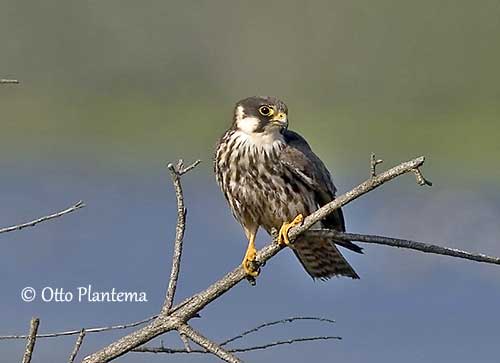
PROTECTION / THREATS / STATUS:
The Eurasian Hobby is threatened by habitat loss through cutting of old growth forest patches, especially in Ukraine, involving local declines. They suffer from hunting pressure in Malta. Human disturbance and wing energy development are two major threats.
A very preliminary estimate of the global population size is 613,000/983,000 mature individuals, but further validation of this estimate is required.
The Eurasian Hobby is currently evaluated as Least Concern.
